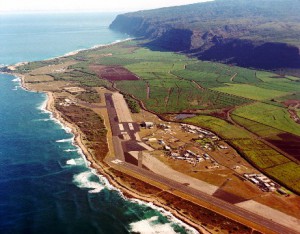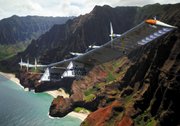By Ray Morgan
Before we went to Hawaii to begin flight tests on the Pathfinder solar-powered airplane, we knew we needed the support of the local community there. Otherwise it was going to be a struggle to achieve any of our goals.
We’d chosen the island of Kauai because of the favorable conditions there for high-altitude flight tests and also for the opportunity to perform demonstration science missions over areas that were uniquely undisturbed by humans. But to take advantage of these conditions, we had to overcome obstacles that were far more down to earth.
For one thing, no one had ever gotten permission to fly an Unmanned Aerial Vehicle (UAV) in FAA airspace there beyond the site of the operator. While we could conduct our high-altitude test flights without leaving the airspace controlled by the Navy, to perform the science missions planned over the island we needed to operate in FAA-controlled airspace.
In a place like Kauai, where the locals are faced with a combination of a high cost of living and few jobs at the professional level, coupled with a highly desirable environment that prompts many to want to find a way to live and work there, there is a natural apprehension about outsiders. In spite of a natural desire to be as helpful as possible, there is a sense of past exploitation, and it is important to be sure that an inappropriate (if unintended) impression isn’t made. It helps to find someone who can serve as your entree into the community. In that way, Dave Nekomoto was our man in Kauai.
Dave is a fourth-generation Japanese-American, born and raised in Hawaii. He was a former Executive Officer at the Navy base where we were conducting the flight tests. Like a lot of the Kauaians we met, Dave had more than one job. Primarily, he was the manager for the local branch of a support contractor on the base. In addition, he worked with the Kauai Economic Development Board in trying to bring more technology-based jobs to Kauai. He also worked as the Director of Operations and helicopter pilot for a local land owner, Mr. Bruce Robinson, whose family is a longtime sugar cane producer in Kauai. The Robinson family owns a third of the island of Kauai.
Dave flies helicopter tours over the Hawaiian Island of Niihau, which is owned by Keith and Bruce Robinson. This private island, Niihau, was determined to be one of only a few options where our fragile aircraft could make a contingency landing on terra firma, making the difference between recovery and loss of the unique aircraft, if an emergency landing had to be made. One thing Dave did for us was smooth the way with Mr. Robinson so that we could land on Niihau if we needed.
Dave also was our “ace” chase pilot, flying a videographer/photographer to document the flights with air-to-air shots near the islands. More importantly, Dave introduced us to the unique culture of Kauai and the Pacific Missile Range Facility (PMRF) where we operated, and helped us “fit in” and establish a good rapport with the local community.
Dave did favors like this because he liked us and considered this type of support part of his job(s). That was the main ingredient we found in any business dealings we did on Kauai. It was a culture where your personality always took you further than the size of your billfold. With Dave we endeared ourselves to him right away because among other things, we devoured all the tasty food he and his friends Vince and Johnny cooked for us in their giant (and I mean GIANT) woks, and we sang with him.
Yes that’s right, we sang.
Dave had — how shall we say — a thing for karaoke. Anybody who was tight with Dave spent time with him at his house singing. This was Dave’s way of relaxing at the end of the day, and he had quite an elaborate setup at his place for it. Microphones, speakers, and acoustics any garage band would kill for…, plus, he must have owned every song ever recorded. The lyrics flashed across a television screen, so all you had to do was punch a button on a computer and there was the song, sans vocals, of course. It was up to you to fill them in, and heaven help you if you were bashful.
No one on the Pathfinder team had a Sinatra voice, but we managed to get everyone to sing something. Even those who were painfully shy managed a few lines of “Happy Birthday.” It was all in good fun, and more importantly, it showed we had the “right stuff,” in that we weren’t afraid to risk embarrassment and that we all trusted each other with our most important possession, our egos.
One could not possibly overstate the importance of these karaoke nights at Dave’s in terms of their bearing on the success of our project. Dave invited many folks from the base that we worked with each day. Also, the whole NASA and AeroVironment team was there, along with spouses, children, and other friends who had come over for a visit. It brought the team together and it made friends with our Hawaiian and military hosts. Without Dave’s karaoke parties we probably still would have eventually ingratiated ourselves with the community, but developing a social relationship certainly broke the ice and formed a basis of trust.
From Dave we learned things about Kauaian culture that we didn’t know beforehand, for instance, the utmost regard Kauaians have for those who educate their children. Hence, in planning our marketing strategy on the island — yes, we had a marketing strategy, don’t you have one for your project? — we developed educational programs in the schools and put together displays at the local museum. We ourselves helped to write the lesson plans and NASA Public Affairs Education Outreach professionals led training workshops for the teachers to show them what we were doing so that they could share this with the kids.
The Kauai Community College sponsored a solar powered racecar, which was a jewel in their crown of technical achievements. We involved the community college by hiring students to work for us at PMRF, exposing them to advanced solar technology by being part of our team. This was done on Dave’s advice and he put us in direct touch with the right people at the college — it helped that his brother-in-law is the Dean of Instruction there. Working with the base commander and public affairs office, the NASA and AV team orchestrated an open house that brought in approximately 1000 local schoolchildren to see the Pathfinder, its payloads, and key parts of the PMRF support equipment. We jokingly called this event the “1000 Kid March,” and the name sort of stuck. It was tremendously successful, and students and teachers from across the state participated in this memorable event.
The community, to put it immodestly, fell head over heels in love with us. “This is a good thing,” people were saying. “These people are doing something special.” That kind of talk has a way of making things happen. Dave was quick to let Hawaii’s political machine know what was going on with our project at PMRF, which resulted in Hawaii’s entire congressional delegation sending a letter to NASA commending us on the success of our program. Suddenly, money that hadn’t been available before appeared, and this gave the project some extra lift, so to speak, making our attempts at a world-record altitude flight a viable goal. Also, people on the island who worked at places we stayed, places we ate, and the airline and car rental agencies all got to know many of the team members. When we had to make travel arrangements that were subject to change with events in our flight schedules, this relationship proved very important.
By the time we left, every Kauaian knew about Pathfinder and what we were trying to accomplish — and, more importantly, they were behind us a hundred percent. To vouchsafe this, we made sure that they felt like Pathfinder was as much their project as it was ours. Everyone on the island was welcome to come out and see the airplane. In busloads they did. When we broke the world record, we held a flight celebration and invited all of our hosts and PMRF support personnel to join us at one of the parks near the base. We provided all the food and entertainment. It was a bash.
Indeed, nothing paid off more for us than cultivating friendships in the community. A small example of this is the day after the big celebration. When we got to the base the next morning and discovered a problem with our phone system, within ten minutes someone was there and it was fixed. A bigger example, of course, is we got the permission we sought to fly outside FAA airspace. We managed to accomplish this with less red tape than we were required to go through at our home base in California.
I’m sure the cynics will look at this and say all we were doing was wooing the community to get what we wanted. For those inclined to see the world this way, you can bet they make little distinction between a friend and an asset. The way I see it, we had friends on the island; if they were assets too, that’s beside the point. We enjoyed sharing our accomplishments with everyone who wanted to be part of the team. The world record was all of ours.
Many times in our projects we think that just being smarter than someone else or having the best idea is all we need. That helps, no doubt, but you’ve got to understand the human side of things. We came to Kauai not knowing exactly how the human dimension would figure into our activities, but we knew whatever way it worked itself out was going to be critical to our success. That’s why we set aside money in our budget specifically for the kinds of activities described here. Call it marketing, but by the time we left Kauai, we were probably spending up to 20 percent of the project time on it.
Bottom line, people are the most important part of any operation. None of us can do much by ourselves; it is only with the help of others that we do great things. It is important that we recognize our interdependence in any enterprise, and the earlier we do it, the easier things are, and the better they work.
Certainly, a lot of factors contributed to our success in the skies above Kauai. No doubt one very important factor is that the people of Kauai felt invested in our success and wanted to do whatever they could to help us reach our goals. Whatever advancements derive from our work on Pathfinder, the support of the Kauaians who helped make it possible must never be forgotten. And, our man in Kauai, Dave Nekomoto, was our guide in finding that support, walking us through blessings, celebrations, traditions, culture, sharing with us his local contacts and mana’o, the Hawaiian word for wisdom.
Lessons
- Cultural differences can impact the success of a project, and it behooves the Project Manager to learn how best to work with unique cultures.
- Soft is hard. All sorts of “crazy ways” of cooperation affect project success.
- When in Rome, behave like the Romans. Adjust to the demands of the local culture, even if it means singing karaoke.
Question
Would you please share an example in which you sang karaoke (figuratively) to the benefit of your project?
Search by lesson to find more on:
- Work Environment










